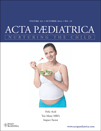Maintenance intravenous fluid prescribing practices among paediatric residents
Abstract
Aim: To investigate the sodium composition of maintenance intravenous fluids (mIVF) used by paediatric residents throughout the United States in common clinical scenarios of arginine vasopressin (AVP) excess.
Methods: We distributed an online survey to paediatric residency programmes asking what type of mIVF (0.2%, 0.45%, 0.9% NaCl or lactated Ringer’s solution) they would administer in four common clinical scenarios of AVP excess (gastroenteritis, pneumonia, meningitis and postoperative) in both a 6-month-old (mo) and a 13-year-old (yo) child.
Results: We had 472 responses, representing 5% of the total paediatric residency population in the United States. Hypotonic mIVF were selected in 78% of children (88.2% of 6 mo and 68.5% of 13 yo). Isotonic mIVF were selected approximately twice as often for patients with meningitis as for those without (21.4% vs. 8.7% 6 mo and 42.8% vs. 27.7% 13 yo; p < 0.001).
Conclusions: The majority of US paediatric residents would prescribe hypotonic mIVF in disease states associated with AVP excess. However, a significant number of residents are using isotonic mIVF. Isotonic fluids are more likely to be prescribed in older children and children with meningitis.




